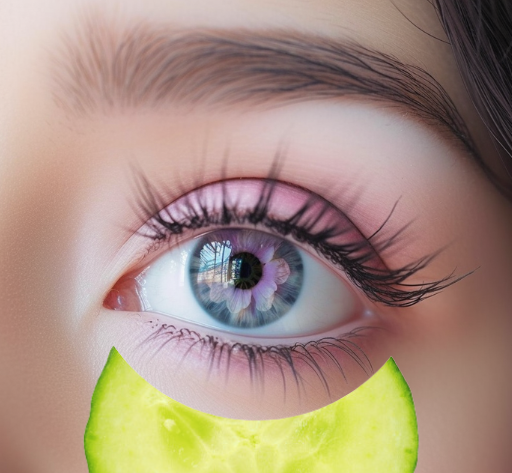Hey there! Feeling tired of those pesky dark circles under your eyes? We’ve got just the solution for you! In this article, we’ll share some fantastic tips and tricks on how to effectively reduce those dark circles and brighten up your under-eye area. Say goodbye to that tired look and hello to a refreshed and rejuvenated appearance. Whether it’s due to lack of sleep, allergies, or simply genetics, we’ve got you covered with practical and easy-to-implement strategies. So, let’s get started on your journey to brighter, healthier-looking eyes!
Causes of Dark Circles Under Eyes
Dark circles under the eyes can be caused by various factors. Understanding the causes can help you address them effectively. Here are some common causes of dark circles under the eyes:
Genetics
One of the main causes of dark circles under the eyes is genetics. If dark circles run in your family, you are more likely to develop them. This is because the condition can be inheritable, making your skin more prone to pigmentation and blood vessels showing through.
Aging
As you age, your skin becomes thinner and loses its elasticity. This can lead to the appearance of dark circles under the eyes. The loss of fat and collagen in the undereye area can make the blood vessels more visible, resulting in a darker and more prominent appearance.
Allergies
Allergies can contribute to the development of dark circles under the eyes. Allergic reactions cause the release of histamines, which can make the blood vessels in the undereye area dilate and become more visible. Additionally, rubbing and itching the eyes due to allergies can worsen the appearance of dark circles.
Poor Sleep
Lack of quality sleep or insufficient sleep can contribute to the formation of dark circles. When you don’t get enough rest, the blood vessels underneath your eyes can dilate, causing a buildup of blood and fluid. This can lead to a darkened appearance and puffiness.
Nutritional Deficiencies
Certain nutritional deficiencies, such as iron deficiency anemia, can cause dark circles under the eyes. When your body lacks essential nutrients, it can affect the skin’s health and lead to the development of dark circles. Ensuring you have a balanced diet is important for maintaining skin health and reducing the appearance of dark circles.
Lifestyle Changes
Apart from addressing the underlying causes of dark circles, making certain lifestyle changes can also help reduce their appearance. Here are some lifestyle changes that can be beneficial in reducing dark circles:
Get Sufficient Sleep
Ensuring you get enough sleep is crucial for overall health and well-being, including the appearance of your skin. Aim for at least 7-8 hours of quality sleep each night. Establish a bedtime routine and create a sleep-friendly environment to promote restful sleep.
Manage Stress Levels
Chronic stress can take a toll on your body, including your skin. Find healthy ways to manage stress, such as practicing relaxation techniques, engaging in regular exercise, or seeking professional help if needed. By reducing stress levels, you can contribute to healthier-looking skin.
Stay Hydrated
Drinking an adequate amount of water throughout the day is essential for maintaining skin hydration. When your body is dehydrated, it can lead to dull-looking skin and exacerbate the appearance of dark circles. Aim to drink at least 8 glasses of water daily and limit your consumption of dehydrating beverages, such as caffeine and alcohol.
Quit Smoking
Smoking can contribute to the development of dark circles under the eyes. The chemicals in tobacco smoke can damage the delicate skin around the eyes and promote premature aging. Quitting smoking not only benefits your overall health but also improves the appearance of your skin.
Limit Alcohol Consumption
Excessive alcohol consumption can dehydrate the body and contribute to the appearance of dark circles. It also dilates blood vessels, making them more visible underneath the eyes. Limit your alcohol intake and opt for hydrating alternatives, such as herbal teas or infused water.
Home Remedies for Dark Circles
If you prefer natural remedies, there are several home remedies that can help reduce the appearance of dark circles under the eyes. While these remedies may not completely eliminate dark circles, they can provide some temporary relief. Here are some popular home remedies:
Cold Compress
Using a cold compress can help constrict blood vessels and reduce puffiness around the eyes. You can achieve this by placing a chilled cucumber slice, a cold spoon, or a damp cloth soaked in cold water over your closed eyes. Leave it on for 10-15 minutes to soothe and refresh the undereye area.
Cucumber Slices
Cucumber slices have long been used as a natural remedy for dark circles and puffiness. Their cooling and hydrating properties can help reduce inflammation and improve blood circulation. Simply place chilled cucumber slices over your eyes for 10-15 minutes, and repeat this process daily for best results.
Tea Bags
Tea contains natural compounds, such as caffeine and antioxidants, that can help reduce the appearance of dark circles. You can use chilled tea bags, particularly green tea or chamomile tea bags, as a compress by placing them on your closed eyes for 10-15 minutes. The soothing and anti-inflammatory properties of tea can help rejuvenate the undereye area.
Potato Slices
Potatoes have natural bleaching properties and can help lighten dark circles. Slice a raw potato and place the slices over your closed eyes for 10-15 minutes. The enzymes and vitamin C present in potatoes can lighten the skin and reduce puffiness.
Almond Oil
Almond oil is rich in vitamin E and has moisturizing properties that can nourish the delicate skin under the eyes. Gently massage a few drops of almond oil into the skin around your eyes before going to bed. Leave it overnight, and rinse off in the morning. Regular use can help reduce the appearance of dark circles and promote healthier-looking skin.
Tomato Juice
Tomatoes contain antioxidants and natural bleaching agents that can help lighten dark circles. Mix equal parts of tomato juice and lemon juice, and apply the mixture to the undereye area using a cotton ball. Leave it on for 10-15 minutes, then rinse off with water. Repeat this remedy several times a week for noticeable results.
Topical Treatments
In addition to home remedies, there are various topical treatments available that can help reduce the appearance of dark circles under the eyes. These treatments usually come in the form of creams or serums and contain specific ingredients that target pigmentation and improve skin texture. Here are some popular topical treatments:
Eye Creams with Retinol
Retinol, a derivative of vitamin A, is known for its ability to fade pigmentation and promote cell turnover. Applying an eye cream containing retinol can help improve the appearance of dark circles over time. However, it’s important to start with a low concentration of retinol and gradually increase as per your skin’s tolerance.
Vitamin C Serums
Vitamin C is a powerful antioxidant that can help brighten the skin and reduce the appearance of dark circles. Look for serums specifically formulated for the undereye area and apply them daily as directed. The regular use of vitamin C serums can promote a more even skin tone and enhance the youthful appearance of the undereye area.
Hydroquinone Creams
Hydroquinone is a skin-lightening agent that can be effective in reducing hyperpigmentation, including the dark circles under the eyes. However, it’s important to use hydroquinone creams under the guidance of a dermatologist, as prolonged and unsupervised use can lead to adverse effects. Follow your dermatologist’s instructions and discontinue use if any irritation occurs.
Kojic Acid Creams
Kojic acid is another ingredient known for its skin-lightening properties. It inhibits the production of melanin, the pigment responsible for skin color, thereby reducing pigmentation and dark circles. Use kojic acid creams as directed and be mindful of any potential skin sensitivity or reactions.
Hyaluronic Acid
Hyaluronic acid is a humectant that can help improve skin hydration and plumpness. When applied topically, hyaluronic acid can reduce the appearance of fine lines and wrinkles, making the undereye area appear smoother and more youthful. Look for eye creams or serums containing hyaluronic acid and use them consistently for optimal results.
Cosmetic Procedures
For more severe cases of dark circles or persistent concerns, cosmetic procedures can be an option. These procedures are performed by professionals and can provide more dramatic and long-lasting results. Here are some common cosmetic procedures used to address dark circles:
Chemical Peels
Chemical peels involve the application of a chemical solution to the skin, which helps exfoliate the top layers, revealing fresher and brighter skin underneath. Superficial chemical peels can help lighten dark circles and improve overall skin texture. However, these procedures should be performed by a trained professional to minimize the risk of complications.
Microdermabrasion
Microdermabrasion is a non-invasive procedure that involves removing the outermost layer of the skin using fine crystals or a diamond-tipped wand. This exfoliation process can help reduce hyperpigmentation and improve the appearance of dark circles. Multiple sessions may be required for satisfactory results, and the procedure is typically performed by dermatologists or estheticians.
Dermal Fillers
Dermal fillers, such as hyaluronic acid-based fillers, can be used to address hollowing or volume loss under the eyes, which can contribute to the appearance of dark circles. By injecting fillers into the undereye area, the hollowed area can be filled, resulting in a smoother and brighter appearance. This procedure should be performed by a qualified and experienced professional.
Laser Therapy
Laser therapy utilizes specialized laser technology to target and break down excess pigmentation, improving the appearance of dark circles. The lasers can also stimulate collagen production, which can help tighten and rejuvenate the skin. Laser therapy should be performed by skilled professionals to ensure safety and optimal results.
Dietary Changes
In addition to external treatments and procedures, making dietary changes can also play a role in reducing the appearance of dark circles under the eyes. Including certain nutrients in your diet can help nourish the skin and improve its overall health. Here are some dietary changes that can benefit your skin:
Increase Iron-Rich Foods
Iron deficiency can contribute to the development of dark circles. Incorporate iron-rich foods into your diet, such as lean meats, leafy green vegetables, beans, and fortified cereals. Consuming these foods can help boost your iron levels and promote healthier-looking skin.
Consume Vitamin K-Rich Foods
Vitamin K plays a crucial role in blood clotting and can help reduce the appearance of dark circles caused by blood vessel dilation. Include foods rich in vitamin K, such as leafy green vegetables, broccoli, Brussels sprouts, and fermented foods like sauerkraut.
Eat Foods High in Vitamin C
Vitamin C is important for collagen production and can help improve skin texture and brightness. Consume foods high in vitamin C, such as citrus fruits, berries, kiwi, bell peppers, and leafy green vegetables. These foods can enhance the health of your skin and contribute to a reduction in dark circles.
Include Omega-3 Fatty Acids
Omega-3 fatty acids are known for their anti-inflammatory properties and can help reduce redness and inflammation around the eyes. Include foods rich in omega-3 fatty acids in your diet, such as fatty fish (salmon, mackerel), walnuts, chia seeds, and flaxseeds.
Stay Hydrated
Proper hydration is essential for maintaining skin health. Drink an adequate amount of water throughout the day to keep your skin hydrated and promote a smooth and youthful appearance. Hydrated skin is less prone to dullness and dark circles.
Prevention of Dark Circles
Preventing the development or recurrence of dark circles is possible by adopting healthy habits and taking care of your skin. Here are some preventive measures you can take:
Protect Your Eyes from Sun Exposure
Excessive sun exposure can worsen the appearance of dark circles and lead to premature aging. Protect your eyes by wearing sunglasses that provide UV protection and by applying sunscreen around the eyes. This can help prevent the breakdown of collagen and the appearance of pigmentation.
Remove Makeup Before Bed
Leaving makeup on overnight can clog the pores and irritate the delicate skin around the eyes, leading to the development of dark circles. Make it a habit to remove all makeup before going to bed, ensuring your skin can breathe and rejuvenate.
Avoid Rubbing or Scratching Your Eyes
Rubbing or scratching your eyes can cause damage to the delicate skin and result in inflammation and dark circles. Instead of rubbing, gently pat the undereye area with the fingertips when needed. Be mindful of any allergies or irritants that could be triggering the urge to rub.
Practice Good Sleeping Positions
Sleeping on your stomach or with your face pressed against the pillow can cause fluid buildup and worsen the appearance of dark circles. Instead, try to sleep on your back or with an extra pillow to elevate your head slightly. This can help prevent fluid accumulation and reduce puffiness.
Using Makeup to Conceal Dark Circles
If you need a quick fix to hide dark circles, makeup can be your ally. By using the right techniques and products, you can effectively conceal dark circles and promote a brighter appearance. Here are some tips for using makeup to conceal dark circles:
Choosing the Right Concealer Shade
Choosing the correct shade of concealer is crucial for a natural and seamless finish. Look for a shade that matches your skin tone or is slightly lighter. Avoid shades that are too dark, as they can make your undereye area appear gray or ashy.
Applying Concealer Properly
Apply the concealer in a triangular shape under your eyes, with the point towards your cheek. This technique helps cover a wider area and ensures seamless blending with the rest of your face. Use a concealer brush or your fingertips to gently blend the product into your skin.
Setting with Powder
To prevent creasing and ensure long-lasting coverage, set your concealer with a translucent or setting powder. Using a fluffy brush, lightly dust the powder over the concealed area. This helps lock the concealer in place and prevents it from settling into fine lines or wrinkles.
Using Color Correctors
If your dark circles have a bluish or purple undertone, color correctors can be helpful in neutralizing the discoloration. Use a peach or salmon-colored corrector to counteract the blue or purple tones before applying concealer. Apply the corrector sparingly and blend it well before moving on to concealer.
Medical Treatments
In severe cases or when other treatments have not been effective, medical treatments may be necessary. These treatments are usually prescribed or performed by healthcare professionals and should be considered under their guidance. Here are some medical treatments that may be recommended:
Prescription Retinoids
In cases where over-the-counter retinol creams are not sufficient, a dermatologist may prescribe stronger retinoids to address the underlying causes of dark circles. These prescription treatments can help improve skin texture, reduce pigmentation, and promote collagen production.
Chemical Peels
While chemical peels were mentioned earlier as a cosmetic procedure, they can also be performed under medical supervision to effectively address dark circles caused by hyperpigmentation or skin texture issues. Medical-grade chemical peels can penetrate deeper into the skin and provide more substantial results.
Light Therapy
Various light therapies, such as intense pulsed light (IPL) or laser treatments, can target the pigmentation and blood vessels underlying dark circles. These treatments safely and effectively reduce pigmentation and promote collagen remodeling. Light therapy should only be performed by qualified professionals.
Dermal Fillers
For cases where lost volume is a significant contributor to dark circles, a healthcare professional may recommend the use of dermal fillers specifically formulated for the undereye area. These fillers can restore volume and improve skin texture, resulting in a more youthful appearance.
Surgical Options
In rare cases where severe or persistent dark circles are caused by prominent blood vessels or excess skin, surgical procedures may be considered. Blepharoplasty, a surgical eyelid procedure, can help remove excess skin and fat, resulting in a more rejuvenated appearance.
When to Consult a Doctor
While most dark circles can be effectively managed with lifestyle changes and home remedies, there are situations where medical intervention becomes necessary. Consult a doctor if you experience any of the following:
Severe and Persistent Dark Circles
If your dark circles are severe, persistent, and not responding to home remedies or over-the-counter treatments, it’s advisable to consult a dermatologist or healthcare professional. They can assess your condition, identify any underlying concerns, and recommend appropriate treatments.
Pain or Discomfort
If you experience pain, discomfort, or itching associated with your dark circles, it’s important to seek medical attention. These symptoms could indicate an underlying condition that requires diagnosis and treatment.
Swelling or Redness
If your dark circles are accompanied by significant swelling or redness, it could indicate inflammation or an allergic reaction. A healthcare professional can help determine the cause and provide appropriate treatment.
Changes in Vision
If you notice any changes in your vision, such as blurriness or impaired vision, along with dark circles, it’s crucial to consult an eye specialist or ophthalmologist immediately. These symptoms could be indicative of a serious underlying eye condition that requires immediate attention.
By understanding the causes of dark circles, making necessary lifestyle changes, and seeking appropriate treatments as needed, you can effectively reduce the appearance of dark circles under your eyes. Remember, everyone’s skin is unique, so finding the right approach may involve some trial and error. Be patient, be consistent, and take care of your skin to achieve a brighter and rejuvenated undereye area.




